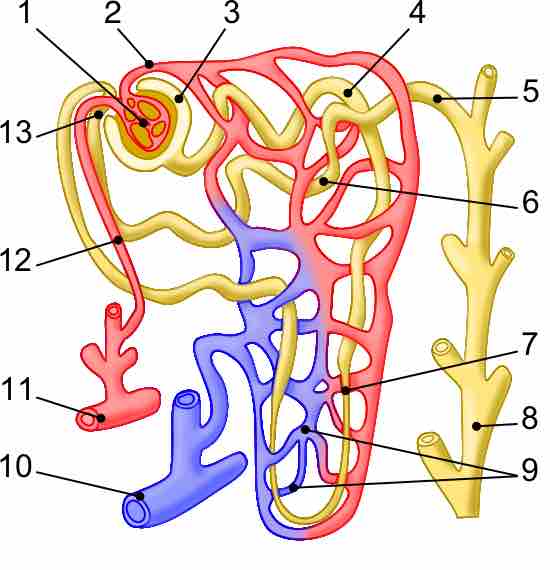A Nephron
A nephron is the basic structural and functional unit of the kidneys that regulates water and soluble substances in the blood by filtering the blood, reabsorbing what is needed, and excreting the rest as urine. Its function is vital for homeostasis of blood volume, blood pressure, and plasma osmolarity. It is regulated by the neuroendocrine system by hormones such as antidiuretic hormone, aldosterone, and parathyroid hormone.

The basic physiology of a nephron within a kidney
The labels are: 1. Glomerulus, 2. Efferent arteriole, 3. Bowman's capsule, 4. Proximal tube, 5. Cortical collecting tube, 6. Distal tube, 7. Loop of Henle, 8. Collecting duct, 9. Peritubular capillaries, 10. Arcuate vein, 11. Arcuate artery, 12. Afferent arteriole, and 13. Juxtaglomerular apparatus.
The Glomerulus
The glomerulus is a capillary tuft that receives its blood supply from an afferent arteriole of the renal circulation. Here, fluid and solutes are filtered out of the blood and into the space made by Bowman's capsule.
A group of specialized cells known as juxtaglomerular apparatus (JGA) are located around the afferent arteriole where it enters the renal corpuscle. The JGA secretes an enzyme called renin, due to a variety of stimuli, and it is involved in the process of blood volume homeostasis.
The Bowman's capsule (also called the glomerular capsule) surrounds the glomerulus. It is composed of visceral (simple squamous epithelial cells; inner) and parietal (simple squamous epithelial cells; outer) layers. The visceral layer lies just beneath the thickened glomerular basement membrane and only allows fluid and small molecules like glucose and ions like sodium to pass through into the nephron.
Red blood cells and large proteins, such as serum albumins, cannot pass through the glomerulus under normal circumstances. However, in some injuries they may be able to pass through and can cause blood and protein content to enter the urine, which is a sign of problems in the kidney.
Proximal Convoluted Tubule
The proximal tubule is the first site of water reabsorption into the bloodstream, and the site where the majority of water and salt reabsorption takes place. Water reabsorption in the proximal convoluted tubule occurs due to both passive diffusion across the basolateral membrane, and active transport from Na+/K+/ATPase pumps that actively transports sodium across the basolateral membrane.
Water and glucose follow sodium through the basolateral membrane via an osmotic gradient, in a process called co-transport. Approximately 2/3rds of water in the nephron and 100% of the glucose in the nephron are reabsorbed by cotransport in the proximal convoluted tubule.
Fluid leaving this tubule generally is unchanged due to the equivalent water and ion reabsorption, with an osmolarity (ion concentration) of 300 mOSm/L, which is the same osmolarity as normal plasma.
The Loop of Henle
The loop of Henle is a U-shaped tube that consists of a descending limb and ascending limb. It transfers fluid from the proximal to the distal tubule. The descending limb is highly permeable to water but completely impermeable to ions, causing a large amount of water to be reabsorbed, which increases fluid osmolarity to about 1200 mOSm/L. In contrast, the ascending limb of Henle's loop is impermeable to water but highly permeable to ions, which causes a large drop in the osmolarity of fluid passing through the loop, from 1200 mOSM/L to 100 mOSm/L.
Distal Convoluted Tubule and Collecting Duct
The distal convoluted tubule and collecting duct is the final site of reabsorption in the nephron. Unlike the other components of the nephron, its permeability to water is variable depending on a hormone stimulus to enable the complex regulation of blood osmolarity, volume, pressure, and pH.
Normally, it is impermeable to water and permeable to ions, driving the osmolarity of fluid even lower. However, anti-diuretic hormone (secreted from the pituitary gland as a part of homeostasis) will act on the distal convoluted tubule to increase the permeability of the tubule to water to increase water reabsorption. This example results in increased blood volume and increased blood pressure. Many other hormones will induce other important changes in the distal convoluted tubule that fulfill the other homeostatic functions of the kidney.
The collecting duct is similar in function to the distal convoluted tubule and generally responds the same way to the same hormone stimuli. It is, however, different in terms of histology. The osmolarity of fluid through the distal tubule and collecting duct is highly variable depending on hormone stimulus. After passage through the collecting duct, the fluid is brought into the ureter, where it leaves the kidney as urine.